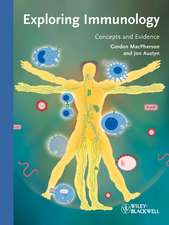Cell Migration in Inflammation and Immunity: Methods and Protocols: Methods in Molecular Biology, cartea 239
Editat de Daniele D’Ambrosio, Francesco Sinigagliaen Limba Engleză Hardback – 29 aug 2003
| Toate formatele și edițiile | Preț | Express |
|---|---|---|
| Paperback (1) | 716.28 lei 6-8 săpt. | |
| Humana Press Inc. – 10 noi 2010 | 716.28 lei 6-8 săpt. | |
| Hardback (1) | 726.88 lei 6-8 săpt. | |
| Humana Press Inc. – 29 aug 2003 | 726.88 lei 6-8 săpt. |
Din seria Methods in Molecular Biology
- 9%
 Preț: 791.59 lei
Preț: 791.59 lei - 23%
 Preț: 598.56 lei
Preț: 598.56 lei - 20%
 Preț: 882.95 lei
Preț: 882.95 lei -
 Preț: 252.04 lei
Preț: 252.04 lei - 5%
 Preț: 802.69 lei
Preț: 802.69 lei - 5%
 Preț: 729.61 lei
Preț: 729.61 lei - 5%
 Preț: 731.43 lei
Preț: 731.43 lei - 5%
 Preț: 741.30 lei
Preț: 741.30 lei - 5%
 Preț: 747.16 lei
Preț: 747.16 lei - 15%
 Preț: 663.45 lei
Preț: 663.45 lei - 18%
 Preț: 1025.34 lei
Preț: 1025.34 lei - 5%
 Preț: 734.57 lei
Preț: 734.57 lei - 18%
 Preț: 914.20 lei
Preț: 914.20 lei - 15%
 Preț: 664.61 lei
Preț: 664.61 lei - 15%
 Preț: 654.12 lei
Preț: 654.12 lei - 18%
 Preț: 1414.74 lei
Preț: 1414.74 lei - 5%
 Preț: 742.60 lei
Preț: 742.60 lei - 20%
 Preț: 821.63 lei
Preț: 821.63 lei - 18%
 Preț: 972.30 lei
Preț: 972.30 lei - 15%
 Preț: 660.49 lei
Preț: 660.49 lei - 5%
 Preț: 738.41 lei
Preț: 738.41 lei - 18%
 Preț: 984.92 lei
Preț: 984.92 lei - 5%
 Preț: 733.29 lei
Preț: 733.29 lei -
 Preț: 392.58 lei
Preț: 392.58 lei - 5%
 Preț: 746.26 lei
Preț: 746.26 lei - 18%
 Preț: 962.66 lei
Preț: 962.66 lei - 23%
 Preț: 860.21 lei
Preț: 860.21 lei - 15%
 Preț: 652.64 lei
Preț: 652.64 lei - 5%
 Preț: 1055.50 lei
Preț: 1055.50 lei - 23%
 Preț: 883.85 lei
Preț: 883.85 lei - 19%
 Preț: 491.88 lei
Preț: 491.88 lei - 5%
 Preț: 1038.84 lei
Preț: 1038.84 lei - 5%
 Preț: 524.15 lei
Preț: 524.15 lei - 18%
 Preț: 2122.34 lei
Preț: 2122.34 lei - 5%
 Preț: 1299.23 lei
Preț: 1299.23 lei - 5%
 Preț: 1339.10 lei
Preț: 1339.10 lei - 18%
 Preț: 1390.26 lei
Preț: 1390.26 lei - 18%
 Preț: 1395.63 lei
Preț: 1395.63 lei - 18%
 Preț: 1129.65 lei
Preț: 1129.65 lei - 18%
 Preț: 1408.26 lei
Preț: 1408.26 lei - 18%
 Preț: 1124.92 lei
Preț: 1124.92 lei - 18%
 Preț: 966.27 lei
Preț: 966.27 lei - 5%
 Preț: 1299.99 lei
Preț: 1299.99 lei - 5%
 Preț: 1108.51 lei
Preț: 1108.51 lei - 5%
 Preț: 983.72 lei
Preț: 983.72 lei - 5%
 Preț: 728.16 lei
Preț: 728.16 lei - 18%
 Preț: 1118.62 lei
Preț: 1118.62 lei - 18%
 Preț: 955.25 lei
Preț: 955.25 lei - 5%
 Preț: 1035.60 lei
Preț: 1035.60 lei - 18%
 Preț: 1400.35 lei
Preț: 1400.35 lei
Preț: 726.88 lei
Preț vechi: 765.14 lei
-5% Nou
Puncte Express: 1090
Preț estimativ în valută:
139.09€ • 144.93$ • 115.16£
139.09€ • 144.93$ • 115.16£
Carte tipărită la comandă
Livrare economică 03-17 aprilie
Preluare comenzi: 021 569.72.76
Specificații
ISBN-13: 9781588291028
ISBN-10: 1588291022
Pagini: 277
Ilustrații: XII, 277 p.
Dimensiuni: 155 x 235 x 26 mm
Greutate: 0.69 kg
Ediția:2003
Editura: Humana Press Inc.
Colecția Humana
Seria Methods in Molecular Biology
Locul publicării:Totowa, NJ, United States
ISBN-10: 1588291022
Pagini: 277
Ilustrații: XII, 277 p.
Dimensiuni: 155 x 235 x 26 mm
Greutate: 0.69 kg
Ediția:2003
Editura: Humana Press Inc.
Colecția Humana
Seria Methods in Molecular Biology
Locul publicării:Totowa, NJ, United States
Public țintă
ResearchCuprins
Chemotaxis and Interaction with Vascular or Lymphatic Endothelium.- Analysis of Integrin-Dependent Rapid Adhesion Under Laminar-Flow Conditions.- Posttranslational Processing of Chemokines.- Chemotactic Profiling of Lymphocyte Subpopulations.- Measurement of the Levels of Polymerized Actin (F-Actin) in Chemokine-Stimulated Lymphocytes and GFP-Coupled cDNA Transfected Lymphoid Cells by Flow Cytometry.- Evaluation of Rho Family Small G-Protein Activity Induced by Integrin Ligation on Human Leukocytes.- Reconstructing Leukocyte Migration in 3D Extracellular Matrix by Time-Lapse Videomicroscopy and Computer-Assisted Tracking.- Analyzing Chemotaxis Using Dictyostelium discoideum as a Model System.- Conditional Transgenic Models to Study Chemokine Biology.- Intravital Microscopy as a Tool for Studying Recruitment and Chemotaxis.- Tracking Antigen-Specific Lymphocytes In Vivo.- Analysis of Homing-Receptor Expression on Infiltrating Leukocytes in Disease States.- Interaction of Viral Chemokine Inhibitors with Chemokines.- Discovery of Small-Molecule Antagonists of Chemokine Receptors.- Visualization and Analysis of Adhesive Events in Brain Microvessels by Using Intravital Microscopy.- Animal Models to Study Chemokine Receptor Function In Vivo.- Assessing the Role of Multiple Phosphoinositide 3-Kinases in Chemokine Signaling.- In Vitro and In Vivo Models to Study Chemokine Regulation of Angiogenesis.- Real-Time In Vitro Assay for Studying Chemoattractant-Triggered Leukocyte Transendothelial Migration Under Physiological Flow Conditions.- Generation of Monoclonal Antibodies Against Chemokine Receptors.- Detection of High-Affinity ?4-Integrin Upon Leukocyte Stimulation by Chemoattractants or Chemokines.
Textul de pe ultima copertă
Cell migration is now well recognized as a critical component of the inflammatory disease process, so that its proper understanding promises to generate both ground-breaking basic discoveries and the development of novel therapeutics. In Cell Migration in Inflammation and Immunity: Methods and Protocols, leading cell biologists and immunologists present their most widely useful and innovative techniques for studying the molecular and cellular basis of this phenomenon. Describing each method in step-by-step detail, the authors provide a series of focused, cutting-edge techniques proceeding from the in vitro analysis of cell migration and the molecular mechanisms underlying this process, to methodologies for the analysis of cell migration in vivo. Methods for the analysis of rapid leukocyte adhesion under flow conditions in vitro are described, which may prove especially fruitful for scientists exploring the molecular mechanisms underlying both vascular recognition and leukocyte-endothelium interaction. Experimental approaches useful in establishing the role of cell migration in the pathogenesis of both acute and chronic inflammatory diseases are emphasized. Each fully tested protocol includes an introduction explaining the principle behind the technique, equipment and reagent lists, and tips on troubleshooting and how to avoid known pitfalls.
Comprehensive and cutting-edge, Cell Migration in Inflammation and Immunity: Methods and Protocols offers novice and experienced investigators alike a collection of powerful techniques for studying the molecular basis and pathophysiological significance of cell migration in inflammatory and immune diseases, as well as for the development of novel therapeutics.
Comprehensive and cutting-edge, Cell Migration in Inflammation and Immunity: Methods and Protocols offers novice and experienced investigators alike a collection of powerful techniques for studying the molecular basis and pathophysiological significance of cell migration in inflammatory and immune diseases, as well as for the development of novel therapeutics.
Caracteristici
Includes supplementary material: sn.pub/extras









